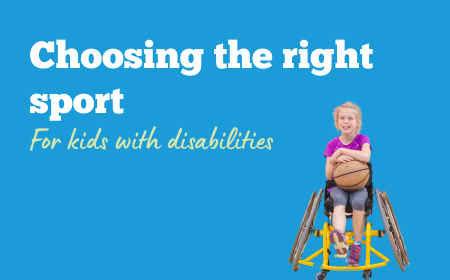Understanding Muscular Dystrophy
HOW OUR THERAPIES CAN HELP YOUR CHILD
Muscular dystrophy is a condition that causes progressive muscle weakness and loss of mobility. Early intervention and personalised therapy are required to help children manage physical and functional challenges.
At South West Kids Clinic, our personalised muscular dystrophy therapy combines Occupational Therapy, Speech Pathology, Physiotherapy, and Dietetics to address key physical and functional challenges.
Each therapy plays a vital role in maintaining function for as long as possible to enable each child to have longer-lasting independence. From providing gentle exercise programs to trialling equipment to make life easier. We focus on improving muscle strength, mobility, coordination, and daily living skills in a supportive, encouraging environment.
This tailored care helps children achieve their goals at their own pace. Our collaborative approach empowers children to build confidence, enhance their capabilities, and thrive in everyday life.
Contact us today to learn how our team can support your child’s journey toward greater independence and well-being.
What is Muscular Dystrophy?
Muscular dystrophy (MD) refers to a group of over 30 genetic conditions that lead to progressive muscle weakening. Over time, muscles lose their strength, making everyday tasks more challenging. While some types of MD appear in infancy or early childhood, others may not present symptoms until later in life.
In children, Duchenne Muscular Dystrophy (DMD) is the most common form, usually becoming noticeable between the ages of 2 and 5. This condition, like others in the muscular dystrophy family, is caused by a genetic mutation that affects how the body produces proteins necessary for muscle health. These mutations can be inherited, but in some cases, they occur spontaneously.
Although there is no cure, early diagnosis and therapeutic interventions can help manage the condition and support a child’s quality of life. At our clinic, we provide a warm and comprehensive approach to care, working alongside families to offer expert therapy and guidance, ensuring your child has the support they need to thrive.
Symptoms and Signs
The signs of muscular dystrophy can vary depending on the type, but all forms are characterised by progressive muscle weakness. In children with Duchenne Muscular Dystrophy (DMD), symptoms typically emerge between ages 2 and 5. These include frequent falls, difficulty running or jumping, and a waddling gait. Some children may also struggle to get up from sitting or lying down, and their calf muscles may appear enlarged due to the replacement of muscle tissue with scar tissue.
Becker Muscular Dystrophy (BMD) progresses more slowly, with muscle weakness often noticed later in childhood or adolescence. Other types, such as Limb-Girdle or Myotonic Muscular Dystrophy, may cause weakness in the shoulders, hips, or face, leading to difficulties raising the arms, walking, or making facial expressions.
Recognising these early signs is crucial, and while the progression of the condition can be difficult, therapies like Physiotherapy and Occupational Therapy can make a significant difference. Our team is dedicated to providing your child with the care they need to manage these symptoms and maintain their independence for as long as possible.
Causes and Risk Factors
Muscular dystrophy is caused by genetic mutations that affect the production of proteins necessary for maintaining healthy muscles. These mutations can be inherited from one or both parents, or they may occur spontaneously without a family history of the condition. The specific type of muscular dystrophy a child develops depends on the gene affected and the type of mutation.
Children who have a family history of muscular dystrophy are at a higher risk of developing the condition. Genetic counselling and testing can help families understand their risks and the chances of passing the condition to their children.
At our clinic, we understand that receiving a diagnosis of muscular dystrophy can be overwhelming. We are here to provide guidance, support, and a plan of care tailored to your child’s needs, ensuring they receive the best possible support along their journey.
Personalised Therapy Solutions We Can Implement
Occupational Therapy for Muscular Dystrophy
Our Occupational Therapists focus on helping children maintain independence in daily tasks, including self-care, school, and play activities. For children with muscular dystrophy, we assess their current abilities and work to preserve and enhance their function. This includes providing strategies to conserve energy, adapt tasks, and promote fine motor skills. We also recommend and train families in the use of adaptive equipment such as specialised utensils, seating systems, bathing aids, and mobility devices that allow children to continue participating in everyday activities with greater ease and safety.
More specifically our Occupational Therapists help children with muscular dystrophy in the following ways:
- Goal directed training
- Development of underlying skills including coordination, strength and range of motion
- Pre & post surgery rehabilitation
- Community assessments and intervention to assist with accessibility
- Equipment and assistive technology prescription, monitoring and support
- Parent/caregiver coaching and support
- Task adaptation or simplification
- Graded task progression
- Liaison with specialist team and key support persons
- Development of fine motor, self care and play skills
Physiotherapy for Muscular Dystrophy
Physiotherapy is key in maintaining movement and strength for children with muscular dystrophy. Our physiotherapists work to improve flexibility, posture, and overall muscle function through targeted exercises. We aim to delay the progression of muscle weakness, prevent contractures, and maintain joint mobility. We also provide guidance on physical activities that are safe and beneficial for the child, while recommending the appropriate mobility aids, such as walkers or orthotics, to ensure the child’s safety and independence as long as possible.
More specifically our Physiotherapists help children with muscular dystrophy in the following ways:
- Assistive technology prescription, monitoring & support
- Functional, goal-directed therapy
- Dynamic Movement Intervention (DMI) intensive therapy
- Spider cage therapy
- Pediasuit
- Serial casting and splinting
- 24hr positioning
- Pediatric Instrument Assisted Soft Tissue Mobilisation (PIASTM)
- Pre and post-orthopaedic surgery rehabilitation
- Aquatic physiotherapy
- Education and family support
- Community assessments and intervention to assist with transitions into school
Speech Pathology for Muscular Dystrophy
Children with muscular dystrophy may experience difficulties with speech and swallowing as the muscles in the face and throat weaken. Our Speech Pathologists support these children by improving their ability to communicate through exercises that strengthen the muscles involved in speech. If needed, we can introduce alternative communication methods, such as augmentative and alternative communication (AAC) devices, to ensure the child can express themselves. For those with swallowing difficulties (dysphagia), we provide strategies to make eating safer and more comfortable.
More specifically our Speech Pathologists help children with muscular dystrophy in the following ways:
- Articulation and clear speech
- Receptive (understanding) language development
- Expressive (use of) language
- Fluency (stuttering) management
- Feeding difficulties and dysphagia if present
- Higher Level language – such as pragmatics
- Social Skills
Dietetics for Muscular Dystrophy
Nutrition plays an essential role in managing muscular dystrophy. Our Dietitians work to ensure children maintain optimal nutrition, which supports muscle function and overall health. We provide personalised meal plans to manage any chewing or swallowing difficulties and help avoid malnutrition or weight issues. Our Dietitians also monitor the child’s growth and recommend modifications to diet consistency, or nutritional supplements if needed, to ensure they receive all the necessary nutrients to support their well-being.
This holistic approach ensures that each child receives tailored support, equipment, and therapies to help them live as independently and actively as possible while managing the challenges of muscular dystrophy.
Why Choose South West Kids Clinic for Muscular Dystrophy Therapy?
Over 15 years of dedicated service
With more than 15 years of experience, South West Kids Clinic has established itself as a trusted paediatric therapy provider. Our dedication to helping children with muscular dystrophy therapy is reflected in the care we provide, offering families reliable support throughout their child’s developmental journey.
Multidisciplinary approach
Our clinic combines Occupational Therapy, Speech Pathology, Physiotherapy, and Dietetics expertise to provide comprehensive therapy plans. This multidisciplinary approach allows us to address a wide range of challenges, ensuring children receive the most well-rounded and effective care available.
Trained by international leaders in the field
Our therapists receive training from international leaders in paediatric therapy, giving them the skills and knowledge to apply cutting-edge techniques. This ensures that we bring the most advanced approaches to our therapy sessions, enhancing the effectiveness of our interventions for children with Asperger syndrome.
We implement the latest evidence-based approaches
At South West Kids Clinic, we stay updated on the latest research and evidence-based practices in paediatric therapy. By incorporating these proven methods, we ensure that each child receives the most effective treatment tailored to their individual needs, leading to better long-term outcomes.
Diagnosis and Testing
Diagnosing muscular dystrophy typically involves a combination of physical exams, family history, and genetic testing. Early signs, such as muscle weakness and delays in reaching motor milestones, often prompt a visit to a healthcare professional. From there, a doctor may recommend specific tests to confirm the diagnosis, including:
- Genetic testing: This can identify mutations in the genes responsible for muscular dystrophy.
- Muscle biopsy: A small sample of muscle tissue is examined to look for signs of muscle damage.
- Blood tests: Elevated levels of certain enzymes, such as creatine kinase, can indicate muscle damage.
- Electromyography (EMG): This test measures the electrical activity of muscles to assess their health and function.
Early diagnosis is crucial for starting therapy and care that can slow the progression of the condition. Our clinic works closely with families to guide them through the diagnostic process, offering support and expertise every step of the way.
Support for Families Living with Muscular Dystrophy
In addition to the services we provide, the following organisations are a great source for parents looking for more guidance in other areas provided by South West Kids Clinic:
Heading Can Go Here
Sed sagittis, libero eu iaculis gravida, quam nisi sollicitudin orci, vitae cursus ligula velit sit amet nulla. Suspendisse ut leo et nibh euismod semper. Quisque a justo ullamcorper, finibus nunc sit amet, blandit dolor. Nullam pharetra ultricies purus, at interdum mi finibus vitae. Phasellus nec tellus mauris. Nullam pellentesque turpis metus, et ornare massa posuere ac. Nunc in lorem quis tortor accumsan aliquam. Suspendisse potenti. Phasellus maximus est nec lobortis finibus. Sed sed risus sit amet est dictum vulputate sed a metus. Cras id tempus enim. Duis sed velit sit amet arcu varius suscipit. Phasellus pretium mauris ac molestie posuere. Integer blandit massa fringilla quam laoreet, a placerat felis egestas. Nulla vitae odio et magna semper aliquam. Nullam tincidunt, mauris quis condimentum congue, libero ligula dapibus ante, vestibulum elementum urna mi et dui.
Heading Can Go Here
Sed sagittis, libero eu iaculis gravida, quam nisi sollicitudin orci, vitae cursus ligula velit sit amet nulla. Suspendisse ut leo et nibh euismod semper. Quisque a justo ullamcorper, finibus nunc sit amet, blandit dolor. Nullam pharetra ultricies purus, at interdum mi finibus vitae. Phasellus nec tellus mauris. Nullam pellentesque turpis metus, et ornare massa posuere ac. Nunc in lorem quis tortor accumsan aliquam. Suspendisse potenti. Phasellus maximus est nec lobortis finibus. Sed sed risus sit amet est dictum vulputate sed a metus. Cras id tempus enim. Duis sed velit sit amet arcu varius suscipit. Phasellus pretium mauris ac molestie posuere. Integer blandit massa fringilla quam laoreet, a placerat felis egestas. Nulla vitae odio et magna semper aliquam. Nullam tincidunt, mauris quis condimentum congue, libero ligula dapibus ante, vestibulum elementum urna mi et dui.
Heading Can Go Here
Sed sagittis, libero eu iaculis gravida, quam nisi sollicitudin orci, vitae cursus ligula velit sit amet nulla. Suspendisse ut leo et nibh euismod semper. Quisque a justo ullamcorper, finibus nunc sit amet, blandit dolor. Nullam pharetra ultricies purus, at interdum mi finibus vitae. Phasellus nec tellus mauris. Nullam pellentesque turpis metus, et ornare massa posuere ac. Nunc in lorem quis tortor accumsan aliquam. Suspendisse potenti. Phasellus maximus est nec lobortis finibus. Sed sed risus sit amet est dictum vulputate sed a metus. Cras id tempus enim. Duis sed velit sit amet arcu varius suscipit. Phasellus pretium mauris ac molestie posuere. Integer blandit massa fringilla quam laoreet, a placerat felis egestas. Nulla vitae odio et magna semper aliquam. Nullam tincidunt, mauris quis condimentum congue, libero ligula dapibus ante, vestibulum elementum urna mi et dui.
Mauris felis purus, finibus et gravida nec, ornare et mi. Sed dolor ex, blandit eget luctus id, egestas vitae tortor. Proin finibus tristique iaculis. Mauris id nulla consectetur, molestie nunc sed, sodales nulla. Maecenas tellus velit, tempor vitae nibh a, vulputate dictum sem. Suspendisse laoreet tincidunt purus a efficitur. Praesent fringilla odio nec sapien pellentesque, eget commodo leo viverra. Vestibulum enim orci, blandit a purus at, tincidunt varius metus.
Mauris felis purus, finibus et gravida nec, ornare et mi. Sed dolor ex, blandit eget luctus id, egestas vitae tortor. Proin finibus tristique iaculis. Mauris id nulla consectetur, molestie nunc sed, sodales nulla. Maecenas tellus velit, tempor vitae nibh a, vulputate dictum sem. Suspendisse laoreet tincidunt purus a efficitur. Praesent fringilla odio nec sapien pellentesque, eget commodo leo viverra. Vestibulum enim orci, blandit a purus at, tincidunt varius metus.
Muscular Dystrophy Therapy FAQs
How can therapy help my child with muscular dystrophy?
Therapies like occupational therapy, speech pathology, physiotherapy, and dietetics can significantly improve your child’s quality of life. Physiotherapy helps maintain muscle strength and flexibility, occupational therapy promotes independence in daily activities with the use of adaptive equipment, speech therapy aids with communication and swallowing, and dietetics ensures proper nutrition to support overall health and muscle function.
Will my child need assistive equipment?
Yes, depending on your child’s condition, assistive equipment like wheelchairs, walkers, or braces may be recommended to help maintain mobility and independence. Our occupational therapists can also provide specialised equipment for daily tasks such as adaptive utensils, seating systems, and communication devices.
How often should my child receive therapy?
The frequency of therapy sessions varies depending on your child’s needs and the progression of their condition. Your healthcare team will work with you to develop a personalised therapy plan that maximises your child’s abilities and helps them stay as active as possible.
Can therapy stop the progression of muscular dystrophy?
Therapies cannot stop the progression of muscular dystrophy, but they can help slow the decline in muscle function and improve quality of life. Early and consistent therapy can make a significant difference in helping your child maintain independence for as long as possible.
Can I expect my child to participate in normal activities at school?
Yes, with the right support and adaptations, many children with muscular dystrophy can participate in school activities. Our occupational therapists and physiotherapists can work with schools to modify tasks, provide equipment, and create an environment where your child can learn and play alongside their peers.













